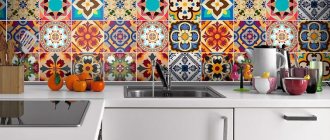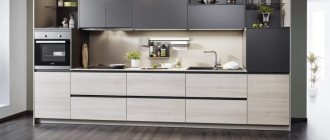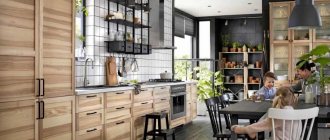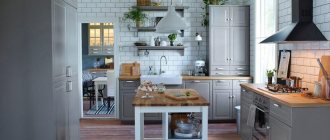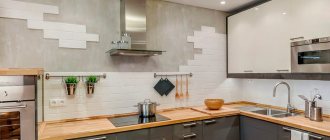Why does one housewife, entering the kitchen, feel a surge of inspiration, while another, on the contrary, gives up? Why is one still full of energy after cooking, while the other feels “like a squeezed lemon”? It’s simple: the options for placing equipment in kitchen No. 1 and kitchen No. 2 are different. The first housewife has everything she needs at hand, while the second one constantly overcomes obstacles during the cooking process. As you can see, the location of household appliances in the kitchen is of great importance. Time, energy, nerves - all this can be saved by approaching this issue rationally.
A sheet of paper, a simple pencil and half an hour of time is enough to draw up a plan for the most convenient kitchen. Of course, if you know the laws of its arrangement. Now we will tell you how best to arrange equipment in the kitchen so that it does not interfere, but helps you prepare your favorite delicacies.
Dimensions in kitchen ergonomics
When choosing a layout option, you need to put personal needs first, not imposed ideas. It is important that the location of the kitchen unit and other furniture corresponds to the specifics of the room. For example, if the width of the kitchen is at least 1.7 m, you can choose a linear layout. If there are two rows, the distance between them should be at least 1.2 m. The maximum value is 1.65 m.
Optimal distances
According to the basic principles, access to everything should be free, the path of movement from the work surface to the stove, sink and refrigerator should be minimal. The resulting working triangle “cooking area – sink – stove” should have a sum of sides of no more than 6 m. The minimum distance between the stove and the sink should be at least 50 cm.
Free opening
This applies to the lower tier of modules, drawers, oven, and dishwasher. Opposite drawers and cabinets, the distance should be at least 90 cm, from household appliances to the opposite surface - 110 cm. In general, the total width of the headset and free spaces should be at least 170 cm.
Safety first
Due to a number of thermal processes, we must not forget about the safety of both the person who cooks and other household members and guests. The hob and oven should be located away from the main passage so that you cannot get burned on hot kitchen utensils. There should be a distance of at least 35 cm between the refrigerator and any heating equipment, from the hob to the window or door - from 45 cm. The height between the hood and the stove is 70-80 cm (depending on the type).
Convenient cooking
If you incorrectly determine the height of the countertops, you may experience back problems. Each level of furniture is selected depending on the height of the person who most often cooks. The average height of the working surface is 85 cm. The height from the floor of the upper drawers is 45 cm. Heavy, bulky items are stored only in the lower modules.
As for the ergonomics of an island kitchen, the height of the working area can be 90 cm. If one of the edges is raised to 125 cm, you get a classic bar counter that can be used as a place to eat.
If you have a small kitchen or the long-awaited 5 places
Somewhere, but in the kitchen in the Khrushchev-era building you definitely won’t be able to make circles! And the layout of apartments in new buildings tends to reduce kitchen space.
What can you do for a small kitchen? Here's what:
- 1. If there's absolutely not enough space for a refrigerator, consider whether you can place it in a hallway, closet or room, perhaps mounted in a cabinet, giving it a more room-appropriate look.
Pros: an obvious advantage is the solution to the issue of placing the unit, and in some cases this, unfortunately, is the only option that allows you to gain at least some free space for movement.
Cons: if you are not afraid of making circles along the route corridor-kitchen or room-kitchen, then we must remind you that the refrigerator is a rather noisy device. Modern models generally tend to make very strange sounds, but what can we say about older models. Are you ready for these sounds to come to you from the corridor or become part of your room?
Work triangle
For the first time, the concept of a working triangle was used by an architect named Neufert from Germany to ensure a high level of kitchen ergonomics. The optimization concerned three main centers: the sink, hob and refrigerator. Each of the blocks must be at the “top of the triangle” along which the hostess moves. Unfortunately, it is not always possible to implement this rule due to non-standard or too small dimensions of the kitchen, combination with the dining room.
- Washing. Main active center. This is where food is prepared, cutlery and utensils are washed, and water is collected. Therefore, this block must be located in the center and always be accessible. A dryer is placed nearby. You should avoid massive cabinets and drawers, as such modules will only interfere with work.
- Cooking surface. Regardless of the type, it should be within reach of the sink, but no closer than 80 cm. In large kitchens, the optimal distance is 110-130 cm. A separate option is to move the sink to an island module.
- Refrigerator with freezer. This category also includes modules for food storage. It is advisable to place this zone in a corner so that there are no non-functional work areas. According to the triangle rule, the distance from the refrigerator to the sink is 1.8 m, to the stove - 1.2 m.
The parameters of the triangle may vary depending on the size of the kitchen and the chosen layout. The ergonomics of a small kitchen must be thought out to the smallest detail so that every area of the room is functional.
The principle of convenience
In addition to following safety regulations, the location of the refrigerator is also important. It would be quite logical to place it closer to the table or to the sink, and for some, for example, to the microwave.
The bottom line is the same - no one wants to make extra circles, even within the confines of their own kitchen.
Of course, you shouldn’t sacrifice safety for the sake of convenience. We advise you to simply consider both factors, as well as the fact that some amenities may need to be given up.
Storage Distribution
- All instruments, utensils and devices that are used every day must be located in the work area.
- In one place you need to collect only items of the same type in order to easily search.
- For convenient storage, it is recommended to use trays, boxes and other dividers. Closed containers are equipped with labels. Fixing rods are used for lids and boards.
- Drawers and systems will simplify access to even the most remote corners of the kitchen. In addition, every square centimeter is used.
- All things should be stored in rows, not in piles, so that you don’t have to constantly move or lift everything. Trays, hooks, rods or special elements are used for separation. The only exceptions are deep dishes and large pans.
- It is recommended to use non-standard storage places, such as rod hooks on cabinet doors, mounts for jars of spices, clothespins for gloves and kitchen towels, nets for small items, etc. Larger items will support the outer side ends (cans, rolling pins, kitchen towel holders, etc.).
- The interior corners of the set, as well as on the work surfaces, are equipped with carousels or shelves with drawers that match the interior.
- One of the corners of the room can be allocated for a tall cabinet, which will act as a storage room. Its height should be for the ceiling itself. Inside there are shelves, drawers, and fastening systems for different types of products or devices.
- The lowest tier of furniture is equipped with wide drawers in which you can put pans, unclaimed dishes, and bottles.
- There is a lot of wasted space under the sink. The use of trays will allow you to organize the storage of detergents and various household chemicals, sponges, gloves, and buckets.
- The sink organizer will simplify the storage and use of dishwashing detergent and sponges.
Even hard-to-reach places can be used correctly. For example, between the wall and the refrigerator you can place a narrow rack on wheels for spices, and equip the apron with a magnetic knife holder.
Where to install the refrigerator is not recommended
The unit cannot be placed next to:
- With a gas or electric stove, overheating of the refrigerator is inevitable.
- With built-in oven below and gas hob above. The oven will not cause harm, since manufacturers provide a layer of thermal insulation. But the gas hob spreads heat in all directions, and the refrigerator body overheats. During cooking, splashes of fat will fall on its wall, and the body will have to be washed every day.
- With battery. If there is no other way out, then it is covered with a screen. The heat goes up, not towards the appliance.
Proper planning of ergonomics in the kitchen
- Linear. The maximum working length is 3.5 m. The sink is mounted in the center, the refrigerator is at the other end of the kitchen. The washing machine or dishwasher is placed close to the sink for easy connection.
- Two lines. The parallel arrangement is suitable for elongated or wired rooms. The main areas are located on one side, the storage cabinet and refrigerator are on the other. All modules must be free to open and functional. At the same time, comfort of movement is necessarily maintained.
- Ergonomics of a corner kitchen (L-shape). The ideal solution for the work triangle. All key centers are located nearby, the modules are separated from the passage area. If the kitchen area is more than 15 square meters, the triangle is preserved, and the free space is supplemented with storage modules or household appliances.
- U-shape. Three walls are used to place the set, furniture and equipment. The layout is applicable only if there is enough free space to move. The space between rows should be 1.2-1.5 m.
- Ostrovnaya. The island can be combined with other kitchen layouts if necessary. This work area contains a sink and a hob. The necessary communications and electricity are pre-installed. The island is necessarily equipped with drawers and cabinets for storage.
If the kitchen is combined with a dining room or living room, it is necessary to separate the zones. In large rooms, you can use a circular layout to achieve unusual, streamlined shapes and lines. In practice, the larger the area, the more difficult it is to properly plan the kitchen. Therefore, it is better to draw a diagram in advance to take into account all the nuances.
Embedding a refrigerator: camouflage and space saving
Manufacturers of household appliances offer built-in models. They are easy to use and fit into any interior and kitchen style.
In large rooms, refrigerators are perfectly hidden in the corner of kitchen units. They come in one- and two-chamber, small and large sizes, up to 200 cm in height.
Models are divided into:
- partially built-in - the door is not masked;
- fully built-in - the door is covered with a decorative panel.
Advantages of the built-in unit:
- Size. Has smaller dimensions than usual.
- Design. You can disguise the refrigerator to suit any style of kitchen.
- Quiet operation. External panels on the built-in unit provide additional noise protection.
Photo gallery
Refrigerator depth
When choosing household appliances, many people wonder how to fit a refrigerator into the kitchen interior.
If the set has already been purchased, then when purchasing a refrigerator, take into account the following points:
- its depth is equal to the depth of the headset;
- The color of the body is matched to the style of the kitchen or made it a bright spot against the background of the entire set.
If you make kitchen furniture to order, then all built-in appliances are taken into account. A fully built-in refrigerator will fit into any interior, as it is disguised with a decorative door.
Premises requirements
From the very beginning, you need to figure out where you can install the stove.
Since 2022, the set of rules (SP) 402.1325800.2018 “Residential buildings. Rules for the design of gas consumption systems." According to this document, the room must be ventilated. It must be equipped with a window with a window, an exhaust ventilation duct, and at the bottom of the door there must be a gap between the floor and the door with an area of at least 0.02 m² to ensure natural ventilation.
The door from the kitchen should open outwards. The height of the room must be at least 2.2 meters, and its internal volume depends on the gas stove:
- not less than 8 m³ - with two burners;
- not less than 12 m³ - with three burners;
- at least 15 m³ - with four burners.
We have indicated only the most important regulatory requirements; you can find out the details yourself by following this link.


